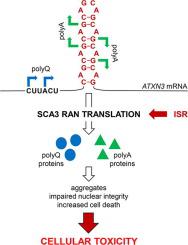Journal of Molecular Biology ( IF 5.6 ) Pub Date : 2020-11-04 , DOI: 10.1016/j.jmb.2020.10.033 Magdalena Jazurek-Ciesiolka , Adam Ciesiolka , Alicja A. Komur , Martyna O. Urbanek-Trzeciak , Wlodzimierz J. Krzyzosiak , Agnieszka Fiszer

|
Spinocerebellar ataxia type 3 (SCA3) is a progressive neurodegenerative disorder caused by a CAG repeat expansion in the ATXN3 gene encoding the ataxin-3 protein. Despite extensive research the exact pathogenic mechanisms of SCA3 are still not understood in depth. In the present study, to gain insight into the toxicity induced by the expanded CAG repeats in SCA3, we comprehensively investigated repeat-associated non-ATG (RAN) translation in various cellular models expressing translated or non-canonically translated ATXN3 sequences with an increasing number of CAG repeats. We demonstrate that two SCA3 RAN proteins, polyglutamine (polyQ) and polyalanine (polyA), are found only in the case of CAG repeats of pathogenic length. Despite having distinct cellular localization, RAN polyQ and RAN polyA proteins are very often coexpressed in the same cell, impairing nuclear integrity and inducing apoptosis. We provide for the first time mechanistic insights into SCA3 RAN translation indicating that ATXN3 sequences surrounding the repeat region have an impact on SCA3 RAN translation initiation and efficiency. We revealed that RAN translation of polyQ proteins starts at non-cognate codons upstream of the CAG repeats, whereas RAN polyA proteins are likely translated within repeats. Furthermore, integrated stress response activation enhances SCA3 RAN translation. Our findings suggest that the ATXN3 sequence context plays an important role in triggering SCA3 RAN translation and that SCA3 RAN proteins may cause cellular toxicity.
中文翻译:

扩展的CAG的RAN翻译在SCA3疾病背景下重复
脊髓小脑性共济失调3型(SCA3)是由编码Ataxin-3蛋白的ATXN3基因中的CAG重复扩增引起的进行性神经退行性疾病。尽管进行了广泛的研究,但仍未深入了解SCA3的确切致病机理。在本研究中,为了深入了解SCA3中扩展的CAG重复序列诱导的毒性,我们在表达翻译或非规范翻译的ATXN3的各种细胞模型中全面研究了重复相关的非ATG(RAN)翻译CAG重复次数增加的序列。我们证明只有在病原体长度的CAG重复的情况下才发现两个SCA3 RAN蛋白,聚谷氨酰胺(polyQ)和聚丙氨酸(polyA)。尽管具有不同的细胞定位,但RAN polyQ和RAN polyA蛋白通常在同一细胞中共表达,从而损害核完整性并诱导凋亡。我们首次提供了对SCA3 RAN翻译的机械洞察力,表明ATXN3重复区域周围的序列对SCA3 RAN翻译起始和效率有影响。我们发现,polyQ蛋白的RAN翻译始于CAG重复序列上游的非同源密码子,而RAN polyA蛋白很可能在重复序列内翻译。此外,整合的应激反应激活增强了SCA3 RAN翻译。我们的发现表明ATXN3序列上下文在触发SCA3 RAN翻译中起重要作用,而SCA3 RAN蛋白可能引起细胞毒性。



























 京公网安备 11010802027423号
京公网安备 11010802027423号